Sometimes you just have to get away. Not that I ever need an excuse to take a walk down to the river – we are fortunate in that the Dungeness is just down the road. But sometimes you just have to turn off the news. Turn off the negativity. Turn away from the fears over which we have no control. Go to a place of healing; listen to the rippling waters bouncing over stones; regain your sanity for a moment in this crazy world we live in.
We pick our way over downed logs along the bank. We stop. Listen. Breathe deeply. There is something about being outdoors that is always so uplifting. This is what is real. The other is just nonsense.
The river is healing in itself, but along its banks, rosehips, plantain, yarrow, elderberry, blackberry, willow, salal, and so much more – and towering overhead, the black cottonwood. We are so incredibly privileged to live in a place where all these natural medicines can easily be found right out the back door. It is a warmish day for late January; the mountains stand tall in the distance, covered with winter’s blanket. An eagle flies overhead; ducks splash about downstream. I almost feel guilty for being able to enjoy something so tactile and serene when others live in a world with no concept of such tranquility and beauty. But I have come here to escape those politics and inequalities. I have come here in search of healing.
Today, we are on a quest for the cottonwood – Populus balsamifera – and more specifically, the buds on windfall branches with which to make a healing salve. We walk under the bridge and listen to the cars rumble overhead; no one seems to see us here amongst the brush and brambles and fallen branches. There is no need to wound any part of the tree; the branches are brittle and easily break off during storms. We have found a good spot.
The sap oozes out as we break off the buds, putting them in our bags. Before long, our fingers are covered with the sticky black stuff and we have collected about a pound. The fragrance is intoxicating. I don’t want to wash my hands. I also have a stash of branches at home that I have collected after the storms. We have a cluster of trees on one edge of the property; they serve to anchor the steep bank while at the same time threaten to fall into the road. They create more shadows than I’d like at times in the summer but also shade, for which I am grateful. The pollen makes my husband’s sinuses swell in the spring – or do we just blame this tree that fills the air with “snow” at the same time grasses are blooming? I love the cottonwoods – and yet I also see their drawbacks. We are all a mixture of things.
By the end of the day, we had collected about a half gallon of buds – approximately 2 pounds. I cleaned out the debris, put the buds in a gallon jar, and then poured a half gallon of organic olive oil over the top. It did not fill the entire jar, which is good. The buds will swell. I once made the mistake of filling quart jars too full, only to have the oil overflow. It was quite comical. I was in my shop, tearing off my clothes, wiping as much oil as possible off the counter and rubbing it all over my body, not wanting to waste a single drop.
But for now, please break away from that image – you have your buds and oil in a jar, right? Ok then, just set the jar aside. That’s it. So easy. You can give it a stir now and then if you want. Then just wait. Not so easy.
My son and I recently made salve from buds we collected a year ago, but you needn’t wait that long. If you are in a hurry, you can gently heat the buds and oil over a double boiler and then let it soak overnight. But I prefer the long-soak method, even if just for a month to six weeks. To make a salve, simply strain the oil through cheesecloth and then thicken it with a bit of melted beeswax. A tablespoon or so to a cup of oil is all you need. More for a harder salve; less for soft (4 T beeswax / 1 c oil makes a fairly hard bar). It keeps a long time; it is naturally antimicrobial.
Now – January and February – is the best time to pick the cottonwood buds. If they are starting to open up into leaves or catkins, it is too late. A warm day will make the buds more sticky; a cool day, less so. If possible, pick a day after a windstorm that breaks the brittle branches from up high and makes them accessible to us lowly ones on the ground. Gather freely. Give thanks. It is a gift, after all.
Rub the oil on your hands and feet. It takes away the aches and pains, heals the cracks and bruises, combats fungal infections, and calms inflammation. The bees use it to make propolis, so you know it must be good.
Seriously. This is amazing stuff. You will feel wonderful. Let everything else in the world go for now.
If you want to learn more about the cottonwoods, take this link to my page, Cottonwood Trees, Buds, and the Gift of Tree Medicine.

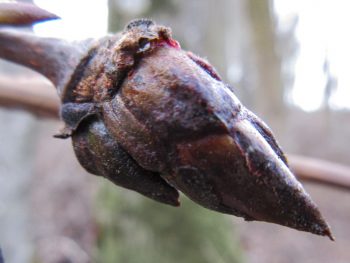
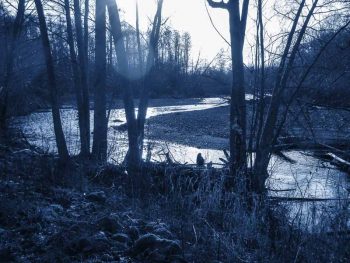
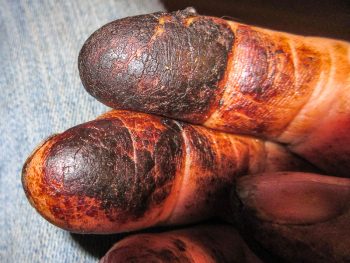
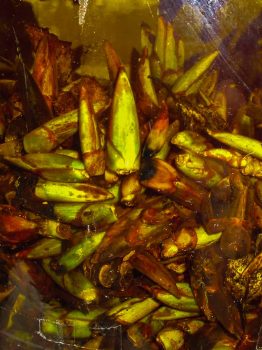
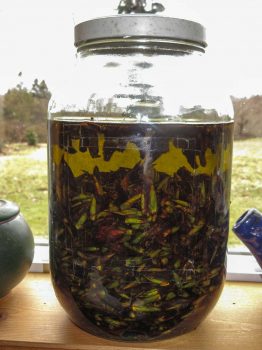
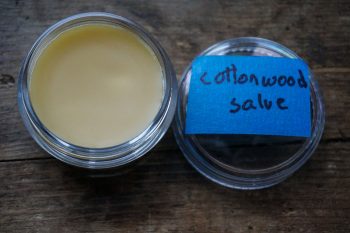
I am so excited to find this in such a timely manner. My boys and I can make a school project out of identifying and locating cottonwoods and collecting their precious buds. Thank you!
Awesome! January & February are perfect times to collect the buds – they are particularly sticky right now! If you are on Facebook, check out the recent harvest by Skeeter Pilarski (Friends of the Trees Society). So fun to get outdoors with the kids and learn about a tree that offers us so much! So many things you can do with the buds. One of my favorite medicinals. Thanks for reading & taking the time to comment! Have fun!
My cottonwood buds have black on them. Is that ok?
You made me go out and look! Haha! Perhaps you have the “black cottonwood” variety? Ours is already leafed out – but there are some broken branches on the ground, and they have dark amber buds. I like to pick them off broken branches after a winter storm, when the buds have begun to swell and are sticky with resin (which can be almost black!). At this point, they are rather dry on the branches, but to my understanding, they are still good – and black cottonwoods also make very good medicine. Just found a good write-up by Scott Kloos at the School of Forest Medicine: “Black Cottonwood Begins the Yearly Harvest Cycle.” Hope that helps!
Generally black buds are older and not so sticky, usually from something that has dropped 2 or 3 years before the fresher the better is what I’ve been told.
I definitely agree! Fresh and sticky is best! So sticky it turns your fingertips brown. Then you know you’ve got good resin. Not sure, though, whether black buds are necessarily old. I am only familiar with what grows in my area. I do know that the older buds get dry. It is usually pretty easy to tell what is new. Good comment. Thanks.
Very cool, now I have something new to look for, collect, and make into balm! Thanks so much, for your insights as well as the healing recipe. Now I know what balm of Gilead is too!
Well, if I were to get technical about it, the “Balm of Gilead” mentioned in the Bible and that was a precious gift from the Queen of Sheba to King Solomon is something totally different, but this is our Northwest version, which has also been used for centuries. I have been putting it on my hands and feet lately and it truly is amazing stuff. I am thinking it would also be nice mixed with a little calendula oil. And I think you have Arnica on your side of the mountains, no? That would be nice for arthritis.